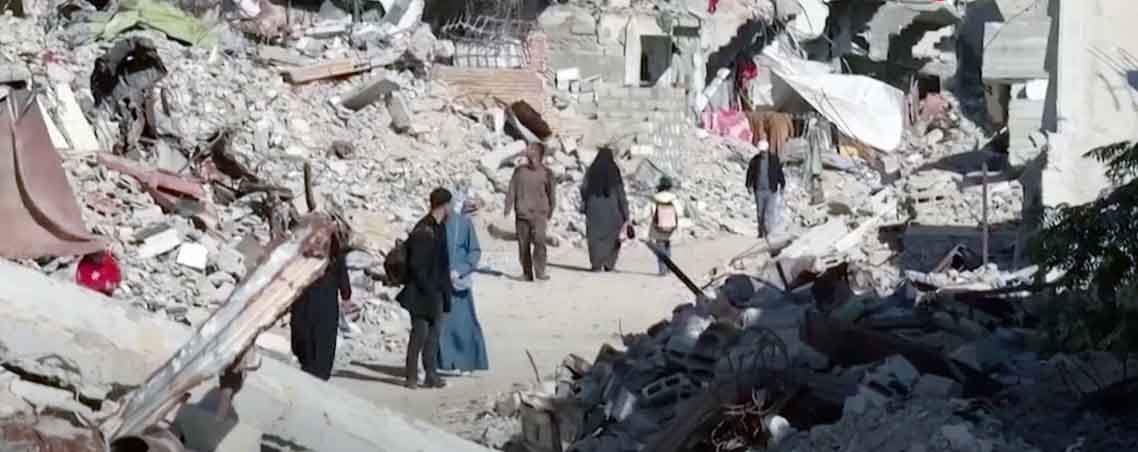Jan. 1, 2025
The Gaza Strip’s people live in terrible conditions within the continuous Israel-Hamas fighting as 2025 starts. The protracted conflict and severe winter conditions have exacerbated already terrible humanitarian problems. Families show the urgent need for international assistance as they deal with dislocation, insufficient protection, and ongoing violence.
Unwavering Conflict and Civilian Cost
Based on data from local health officials, the conflict between Israel and Hamas—now in its fifteenth month—has killed nearly 46,000 Palestinian deaths. The civilian toll remains disproportionately high, with women, children, and the elderly among the most impacted.
Israeli raids on heavily populated southern Gaza on January 7 aimed at least 17 deaths, including five children sheltering in a tent. The Israeli military declared that these operations attempted to remove Hamas operatives implicated in the October 2023 assaults, while others argue that little information is supplied to warrant the amount of civilian losses.
“The situation here is unbearable,” said a Gaza resident who lost family members in the recent airstrikes. “We wake up every day not knowing if we’ll make it through the night.” Such testimonies underline the human cost of the battle.
Humanitarian Crisis Worsens
The humanitarian crisis in Gaza has reached grave levels. Nearly two-thirds of Gaza’s 2.3 million citizens are internally displaced, with many living in improvised shelters or temporary tents that give little protection from the weather.
According to Medical Aid for Palestinians (MAP), the hard winter has aggravated the misery. Temperatures have plunged below freezing, and torrential rainfall has inundated camps, leaving hundreds without dry clothing or bedding. Basic basics like food, clean water, and medical supplies are scarce, while hospitals struggle to operate owing to acute fuel shortages.
“The healthcare system is on the brink of collapse,” said a statement by the World Health Organization (WHO). “Without immediate humanitarian aid, the situation will only deteriorate further.”
Communication disruptions and restricted access for relief agencies have aggravated the crisis. The United Nations Relief and Works Agency (UNRWA) believes that less than 5% of the essential humanitarian aid has reached Gaza in recent weeks owing to continuous blockades and military operations.
Winter’s Impact on Displaced Communities
The cold season has worsened the hardship of displaced families. Torrential rain and powerful winds have damaged makeshift shelters, leaving many exposed to the terrible weather. Children are particularly vulnerable, with increased incidences of hypothermia and respiratory diseases recorded in congested camps.
One relocated mother detailed her plight: “My children cry at night because of the cold. We have no blankets, no warmth, and hardly enough food to survive.” Such examples reflect the severe need for coordinated international aid efforts.
International Response and Diplomatic Stalemates
International efforts to address the situation have been faced with severe hurdles. The United Arab Emirates and Israeli foreign ministers met recently to examine potential possibilities for humanitarian help and a peace accord. However, differences over critical matters, notably the release of hostages and prisoner exchanges, have delayed progress.
Hamas representatives have emphasized their interest for a true peace and the easing of the restriction on Gaza. In the meantime, Israeli authorities stay up with that any peace should integrate certificates for long haul security and the demobilization of aggressor groupings.
The international community has called for urgent action. António Guterres, the UN Secretary-General, emphasized, “We must prioritize the protection of civilians and ensure humanitarian access to those in need.”
Broader Implications
The continual struggle and compassionate emergency have vast repercussions. Notwithstanding the prompt enduring of Gaza’s inhabitants, the conflict has stressed worldwide connections and raised pressures in the Center East. Basic freedoms groups have condemned the two sides for neglecting global regulation, calling for independent examinations concerning stated massacres.
The economic impact on Gaza is as terrible. The blockade has decimated industries, leading to soaring unemployment and poverty rates. Educational facilities remain closed, denying children access to learning and growth possibilities.
The Call for Justice
The tenacity of Gaza’s people continues to inspire global solidarity, but many feel that justice remains elusive. International organizations have demanded for accountability for the pain imposed on civilians.
One Gaza resident expressed the situation poignantly: “We do not ask for much—just the chance to live in peace, to rebuild our homes, and to give our children a future.”
Conclusion
As the new year begins, the residents of Gaza face unprecedented problems. With not a single quick finish to the contention can be found, the center should go toward supplying charitable counsel and tracking down discretionary options for alleviate the misery. The global local area has an ethical obligation to act clearly and guarantee that the voices of the mistreated are heard.
Sources
- Associated Press: Israeli strikes kill 17 people in Gaza, nearly all of them women or kids
- Reuters: Hamas stands by demand for end to Gaza war under hostage deal
- Medical Aid for Palestinians (MAP): Surviving winter in Gaza
- World Health Organization (WHO): WHO Gaza Report
- UNRWA: Humanitarian Crisis in Gaza
- The New Humanitarian: In Gaza, winter is not just a season
- The Guardian: Gaza’s suffering: a deepening disaster
- Politico: Hurdles remain as Israel and Hamas inch toward ceasefire
- Middle East Eye: Massacring Palestinians in Gaza

